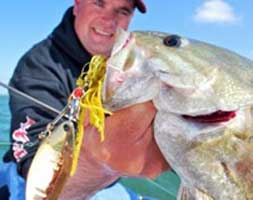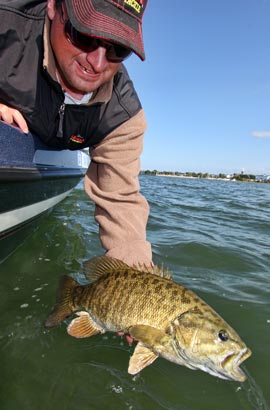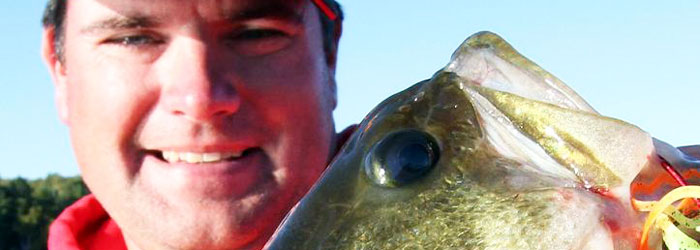Adjustments for Smallmouths

Sometimes as the sun climbs, these fish begin to cruise (often in packs) and the fish often get spookier as the sun climbs.
Classic Smallmouth Habitat
In so many of the best smallmouth bass fisheries across the Midwest, classic smallmouth bass habitat is often shallow reefs and bars that are covered with boulders and rock. Many of these top locations are sometimes marked hazards where you would take out a lower unit if you tried to motor across these locations.
Obviously, weeds and other types of structure like shallow sand flats, cut banks and other types of structure will hold fish and the type of structure can vary greatly from lake to lake but the shallow boulder pattern is pretty universal. If these locations exist on a body of water and if there are any numbers of smallmouth bass around, there will typically be some fish on these locations.
Weather and Time of Day
How these fish relate to these classic locations however is often dictated by weather for so much of the open water season. On many lakes with good visibility, these spots can often be better early in the morning or late in the evening. But if the weather is stable, we often find that these fish remain on top of these spots all day.
So why do they bight better in the morning and evening? I honestly believe that these fish set up in ambush locations and are much easier to approach when the sun is low.
 Fishing High Noon
Fishing High Noon
When the sun gets high, you can see the fish easier but they can also see you where there is good visibility. Sometimes when the sun climbs, the fish submerse themselves into the dark shadows of large boulders. Catching fish is as simple as casting to the dark spots you can see when wearing polarized glasses. But not all fish hold in the shadows.
Sometimes as the sun climbs, these fish begin to cruise (often in packs) and the fish often get spookier as the sun climbs. Spooky cruising fish have to be approached much differently. This situation often calls for fishing fast and fan casting across structure until you contact fish and when you find them, make it count by tossing back on following fish.
Understanding how these fish move through the course of the day and how they adjust as the weather changes is crucial for adapting your strategy on the go each day. Fish that are cruising or roaming over a bar in schools must be approached much differently, for example, than isolated fish that are holding in the shadow of a distinguishable boulder.
Fishing Calm Conditions
Many smallmouth bass anglers love calm conditions or light winds and on big water like Mille Lacs and the Great Lakes, calm conditions are much easier to fish. Walleye anglers often pray for wind where as bass anglers often pray for no wind. The curse of wind for smallmouth bass is often water visibility. If the water gets churned up with debris and visibility gets cut down, these fish get harder to catch.
There are some adjustments however that you can make to combat the affects of wind. A friend of mine, Ralph Steiger operates a successful charter captain business on Lake Michigan along the Indiana Shore east of Chicago and spends a lot of time fishing for smallmouth bass where there is no shortage of wind.
His strategy is simple but works. When you are dealing with strong winds, spend as much time as possible on good spots where you know there are fish and fish through the area slow. Grind out the spots and fish close to the bottom.
Adverse Weather Fishing
Typically, bass will slide down the break during adverse weather conditions and hold tight to the bottom. In these conditions, jigs and tubes that can be crawled along the bottom really shine. This is not typically a situation where you will have success fishing fast or high in the water column. How far down the break to fish can depend on the time of the year with some of the deepest fishing happening in the fall.
Before the fish move deep in the fall, my starting point is often measured by the swells. Take the height of the swell and times it by 2. In 3 foot seas, take 3 times 2 and start fishing in 6 feet as a starting point get below the turbulence of the swells.
Typically, smallmouths will duck below the strong reverse current that is generated by heavy seas.
Visibility is the Kicker
Water visibility is the kicker. If you can still see your prop when fishing in strong wind, you are at an advantage. If water visibility has been churned up, look for cleaner water even if that means fishing spots that are not as good.
There are so many great smallmouth bass fisheries that are often large enough where daily weather and wind can really change the patterns from day to day but some of these premises can also be applied to much smaller fisheries.
During stable weather with little wind, search shallow and fish fast. When storms and strong winds churn up the water, slide out and fish slow. These adjustments can help you catch many more bass.
About Jason Mitchell
Jason Mitchell hosts the popular outdoor program Jason Mitchell Outdoors which airs across the Midwest on Fox Sports North and Fox Sports Midwest. Before television, Mitchell earned a reputation as a top hunting and fishing guide on Devils Lake, North Dakota where he spent over two hundred and fifty days each season on the water and ice for over a decade. Mitchell shares his insights and tactics learned from an extensive amount of time on the water in each article.
You’ll find more insight from Jason on these links



